In our Hobby Heresy series, we encourage thinking outside the box (literally) when putting models together. They aim to make hobbyists comfortable growing beyond imitating the models they see in their Codexes, and serve as a source of inspiration for anyone wanting to make an army that’s uniquely their own. This week, Buffalochicken is talking about the fine art of finding, collecting, and using bits.
If the converter’s desktop is indeed a forge, bits are the little ingots to be reshaped into something grander. If you’re not yet acquainted with the word “bits” (or “bitz,” for those of Orky inclination), it refers to pieces collected – some might say “hoarded” – for use in future projects.
This article is going to cover how bits factor into the world of converting, the different types of bits, how to sort your bits collection, and various other tidbits – it all sounds pretty elementary, but a column all about converting would be remiss if it didn’t cover the topic at some point. At the very least come for the conversion pictures, and stay because you might actually get some good ideas!
Kitbash Versus Conversion
Before we go any further, I’d like to clarify two words often used interchangeably – “kitbash” and “conversion.” While the definitions might change slightly depending on who you ask, the ones below are common convention.
- Kitbash: Assembling one kit using some parts from another. This might mean swapping heads and weapons between different Space Marine infantry boxes, or gluing Tyranid trophies onto your Imperial Guard tanks. If you’re simply using glue to connect pieces from different kits, you’re most likely working on a kitbash.
- Conversion: If you find yourself cutting and carving to re-pose a model or get pieces to fit where they’re not designed to attach, you’re working on a conversion. Because you’re joining pieces that aren’t designed to fit together, greenstuff (a two-part sculpting epoxy) is often used to help secure pieces and smooth joins.
While the word “conversion” will be used throughout this article, most of the tips apply equally well to kitbashes – indeed, while they’re less work than conversions, a thoughtful and elegant kitbash will outshine a clunky conversion. One is not “better” than the other… it’s all about execution.
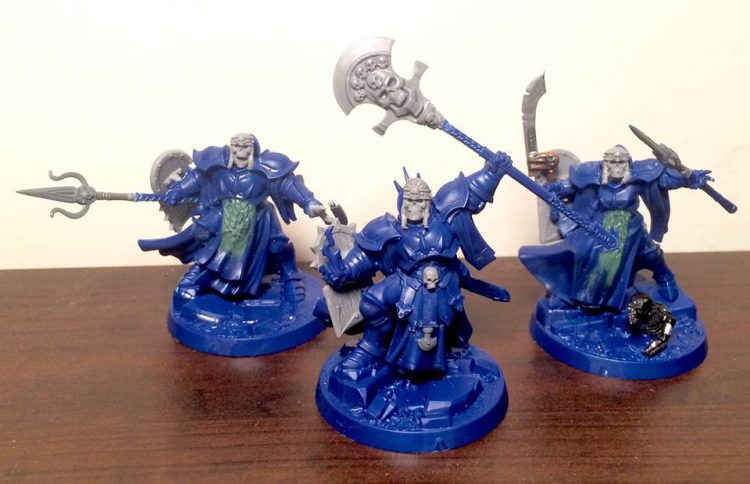
Bits and Conversions
Having covered the requisite vocabulary, let’s continue expanding the connection between “bits” and “conversions.” There are two main ways that conversions come about:
- Bits-First: This is when a particular bit captures your imagination, and inspires you to make a conversion that incorporates that bit in a creative (and usually prominent) way.
- Idea-First: This is when you have a general idea of what you want to create, and then dig through your bits collection to bring that idea to life.
While I would guess that most conversions fall into the latter category, some of my favorite projects were inspired by a single bit. You should never be afraid to indulge your attraction to a specific bit – even if that means dabbling in conversions that cross faction lines (scandalous!). The Warhammer 40,000 universe is teeming with examples of looted relics, improvised armor, exotic steeds, seized weapons, and outlandish bio-tinkering… just go with what looks cool, and the narrative will forge itself.
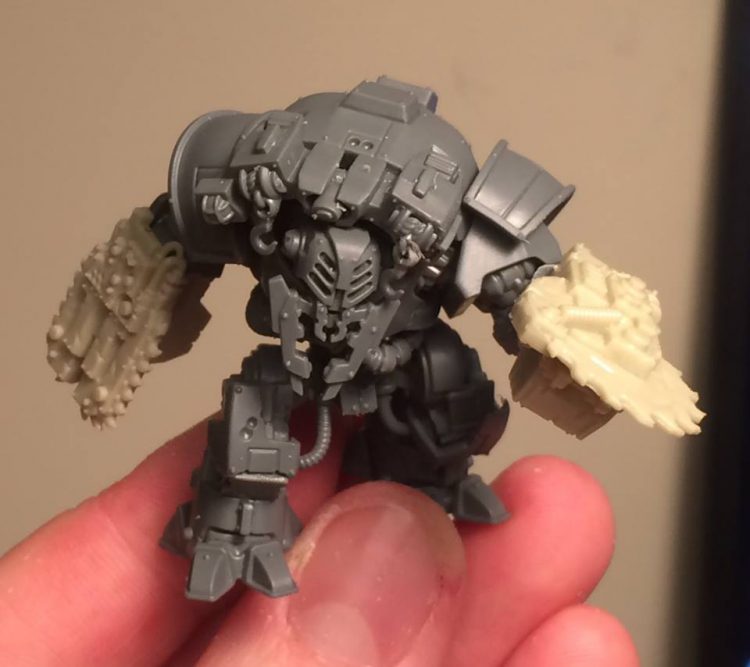
Buzzsaws and Ambots both make me feel tingly in my tummy, in a good way, so as a converter it was my mission to bring together these star-crossed lovers – even if Orkish and Imperial origins would normally contrive to keep them apart.
Next time you see bit that you love the look of, regardless of faction, take a moment to think about it. How could it fit into your army? See below for a few examples Bits-First conversions:
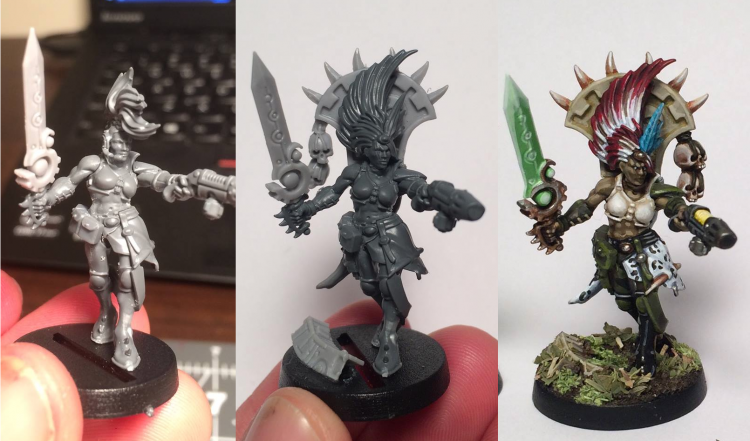
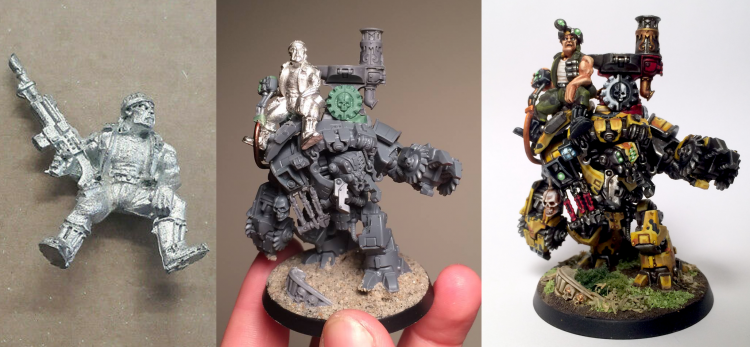


While the above examples are fun, you most often won’t see a single bit and decide to build a conversion around it – instead, you’ll have a character or model in mind and wind up digging around for the right bits to bring that vision to life. When working on one of these Idea-First conversions, it helps to think of bits as LEGO pieces. And as anyone who’s worked with LEGO knows, having your pieces organized is a great way to minimize frustration and wasted time while trying to realize a vision.
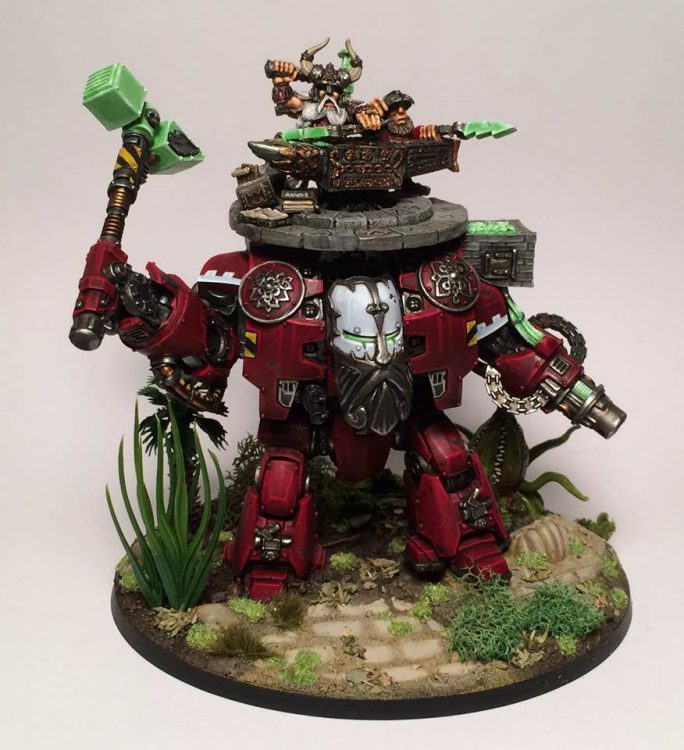
In my mind, bits fall into several broad categories: leftovers, purchases, and scraps. We’ll look at each of those categories below.
Leftovers
Definition of Leftovers: Pieces left over from assembled model kits.
Acquisition of Leftovers: Most modern Games Workshop model kits come with plenty of extra bits for various alternative builds and weapon options. By the time you’ve assembled a few boxes, you should have a solid baggie of these. It’s also worth talking to your friends – if they’re not into making their own conversions or kitbashes, they may be willing to pass their bits collections off to you. For groups that use Facebook or an alternative message board/chatroom, it’s worth having a thread dedicated to bits-hunting for people to post requests or offers. Some game stores or gaming groups that have an established home base even pool their leftovers, allowing anyone in the group to pull what they need for projects. This is a great way to avoid bits sitting uselessly in a hoarder’s closet (boooo) instead of being given new life in a hobby project (hells yeah)!
Storage of Leftovers: While many hobbyists sort these bits based on what kit or faction they came from, if you intend on getting creative, I recommend sorting them by type of bit instead. Example categories to separate by include heads, small firearms, close-combat weapons, large pieces of armour, small mechanical bits, gothic accents, basing details, or grenades/pouches. This sounds like a tiny bit of advice, but it’s a real game-changer when it comes to finding exactly the right bit for the job. And don’t worry about investing in fancy expensive storage containers… I use cheap Ziploc baggies for most of my bits, and they work just fine.

Use of Leftovers: If you’ve sorted your bits by type instead of by kit, it becomes much easier to play around with alternative bits in a conversion. What’s easier – opening ten different baggies to hunt down different head options for an Inquisitor you’re converting, or simply go to your “heads bag” and pore over the options there? You might also see options you wouldn’t have thought to look for – an old plastic Eldar power glove might present a much more elegant and exotic option for your Inquisitor than the modern power fist you planned on using, but you wouldn’t have thought to try it if your bits were still sorted by faction.
Purchases
Definition of Purchases: These are bits that didn’t come from kits you already have, but were instead bought with specific projects in mind. Purchases are usually made after scouring all leftover bits and checking with friends to ensure that a purchase is needed.
Acquisition of Purchases: You should always experiment with the bits you already have before jumping to buy “the perfect bit” online – often, limiting your available resources is one of the best ways to get really creative. By rotating bits in unusual ways, trimming them, or looking into bits from different factions, you can often do creative problem solving before needing to buy anything new (and wind up with a far more original conversion, to boot).
The preferred bits-hunting website is eBay, where you can search for the part needed and sort by “Price + Shipping: lowest first.” Examples of reliable bits shops over the years are Hoard O’ Bits and window-box, but many others exist. Before hitting “check out” on an order, I always go back to the main store page and sort their entire item catalogue by “Price + Shipping: lowest first.” This is a great way to scroll through a few pages and pick up other intriguing or valuable bits at a great value – you’re already paying a flat $6 or so on shipping, so might as well get the most out of your order!

Storage of Purchases: When purchased bits arrive for specific projects, I start “project baggies” with all the relevant bits stored together. Sometimes I’ll put a brainstorm project baggie aside for months or literally years, so keeping the relevant bits in one place for that project is a huge help.
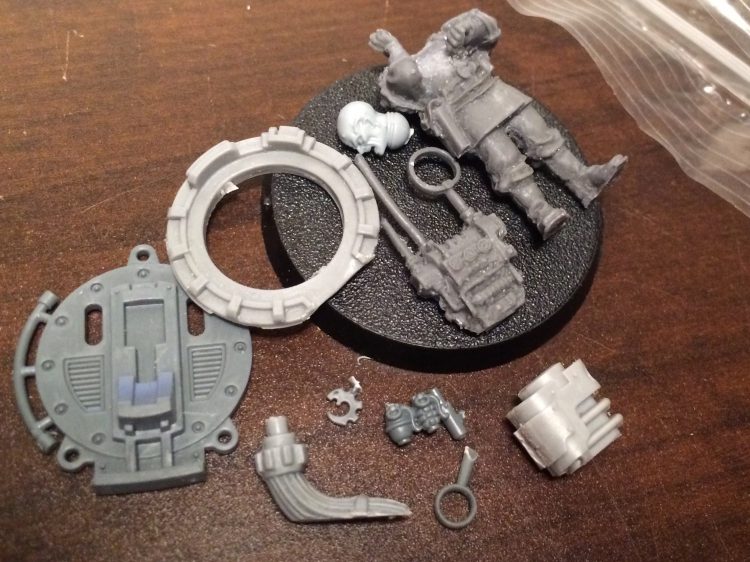
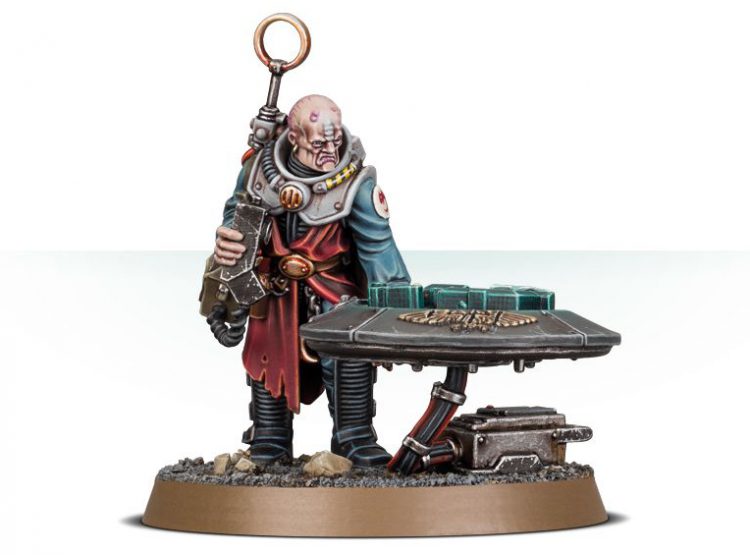
Use of Purchases: This is the easy part – you bought these bits specifically because you had a use for them in mind. Put them to use as intended!
Scraps
Definition of Scraps: “Scraps” come from any number of sources, and are typically larger than the more conventional bits described above. Scraps can be old toys, broken Christmas ornaments, oddly-shaped bottles, dismantled electronics, strips of wire mesh, or anything else that might be useful in a future modelling project. Don’t just think about tiny soldiers – many scraps are fantastic for terrain projects as well.

Acquisition of Scraps: Most common are pieces of old toys – it’s amazing how much bit potential can be scavenged from an old Zoid or disjointed Transformer, for example. The most recent addition to my scraps box is half of a tea strainer ball, which my loving girlfriend agreed to sacrifice so that I might harvest some fine wire mesh from it (don’t worry, readers – she has many more tea balls where that came from).
Storage of Scraps: With scraps, which tend to be larger than conventional bits, I don’t get fancy. All of my scraps go into a bin which lives by my hobby space.
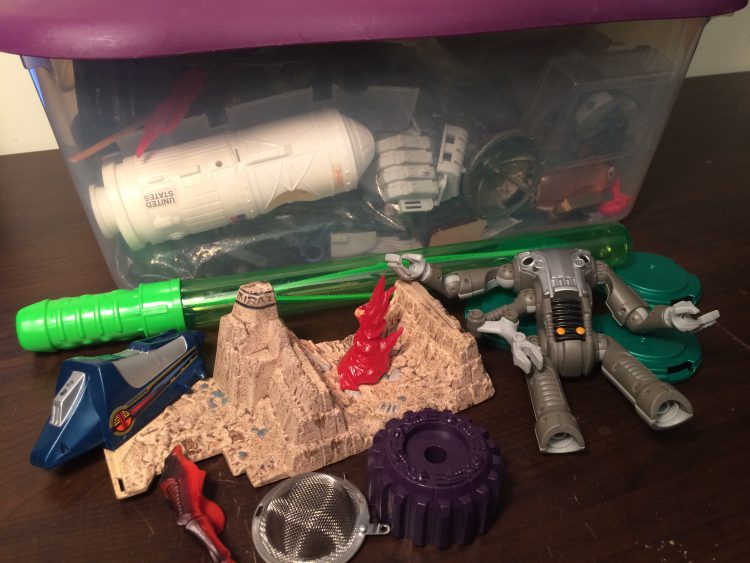
Use of Scraps: Strategic use of a broken Kenner Alien can provide the foundation of a bio-titan conversion or thematic basing material for an entire squad of Ultramarine Tyrannic War Veterans. Even things that would otherwise be considered trash – translucent tubes used for bubble wands, industrial-looking recyclable 6-pack holders, oddly-shaped bottles, flickering LED candles smuggled off while helping your cousin clean up after her wedding – become potential centerpieces when used cleverly on a miniature scale. Start looking at everything through this lens, and the world will be transformed into a magical free arts-and-crafts gift shop.

What To Do Now?
With a new eye for bits, take a fresh look at your own hobby collection and this horrible garbage world we live in. Maybe pour yourself a pint, put on some Netflix, and spend a relaxing evening sorting your bits into baggies. Or grab a box and go raid your attic for old broken toys. Heck, why not rummage through public recycling bins for fancy bottle caps while your significant other pretends they don’t know you and reconsiders their entire life? No matter how you go about it, start growing and organizing your bits collection. As the Narrative Forge articles continue, it’s my goal to inspire you to push your boundaries and try some fun conversions… and you’re going to want lots of bits at your fingertips when inspiration strikes!
In the meantime, if you have any conversions or projects of your own that you want to share, we’d love to see them! Post something in the comments below or shoot us an email at contact@goonhammer.com
You can always find BuffaloChicken’s latest model photos on Instagram.


